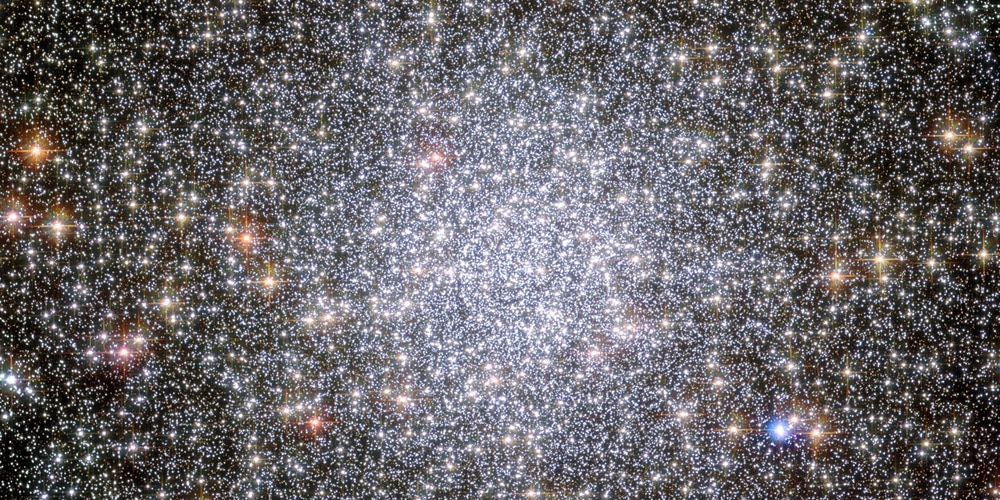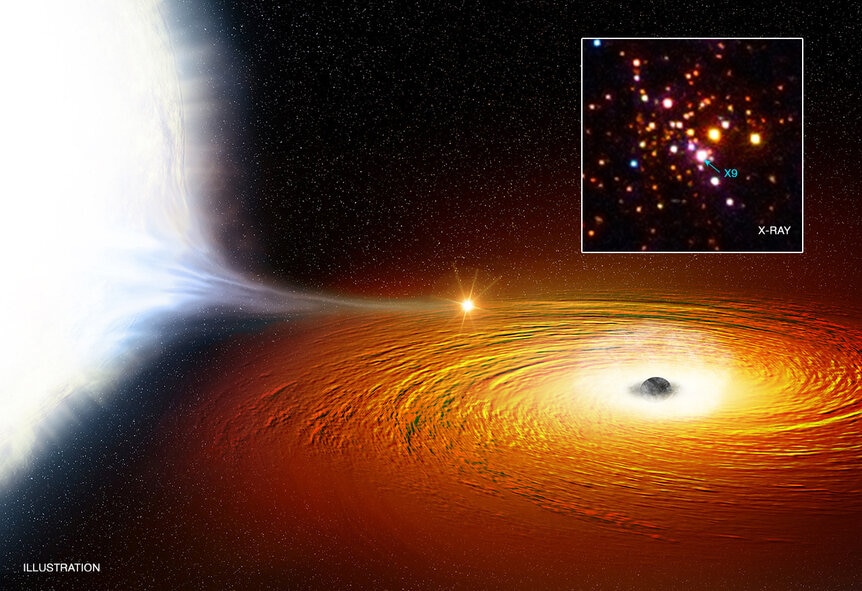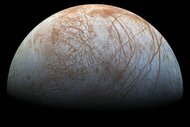Create a free profile to get unlimited access to exclusive videos, sweepstakes, and more!
Astronomers find a black hole eating a white dwarf

Astronomers have found what may be one of the weirdest heavenly couples yet: What looks very much like a black hole physically tearing off and eating stuff from a white dwarf.
If you’ve wondered what makes an astronomer’s neck hair stand on end, this would be a good example.
The binary is called 47 Tucanae X9, meaning it’s the 9th source of X-rays seen coming from the globular cluster 47 Tucanae (usually just called 47 Tuc). I know, that doesn’t seem to help, but I can explain.
A globular cluster is a tightly knit collection of hundreds of thousands of stars, all in a compact, roughly spherical ball a few dozen light-years across (hence the name). Our Milky Way galaxy is orbited by over 150 known globular clusters, and 47 Tuc, about 17,000 light-years from Earth, is one of the most massive. Globulars tend to be very old, 10 – 12 billion years old, and most of the massive stars in them have already exploded as supernova. These leave behind neutron stars (ultra-compressed balls of subatomic particles with the mass of a star but only a dozen or kilometers across) or black holes.
Even stars like the Sun (considered a low mass star) will have used up the fuel in their cores, turned into red giants, then blown all their outer layers away. What’s left of them are called white dwarfs: the cores of the former normal stars. White dwarfs have about the mass of the Sun, but are compressed into balls only about the size of the Earth. They have tremendous gravity and can be very hot.
47 Tuc has a handful of X-rays sources in it. Only the most powerful of cosmic forces can generate high energy X-rays. For example, a compact object like a neutron star, black hole, or white dwarf that’s drawing material off a nearby star; as that material plunges down, it gets incredibly hot and blasts off X-rays.
47 Tuc X9 was thought to be one of these, with a white dwarf ripping matter off a star like the Sun. But newer observations show this can’t be the case; the presence of radio emission made it more likely this was a black hole eating something.
Newer observations made using the Chandra X-Ray Observatory support this idea. The X-rays coming from X9 indicated the strong presence of oxygen in the material being stripped away from the donor star. The amount was so high, it’s extremely unlikely the donor star is one like the Sun; you’d see more of other elements in it. But a white dwarf can be loaded with oxygen, because it’s formed from a star that’s already converted most of its lighter elements, like hydrogen and helium, into oxygen.
Not only that, but the astronomers studying this object found that the X-rays changed brightness, getting brighter and fainter, very clearly in a cycle that lasts a mere 28.18 minutes. That’s a strong indicator of an orbital period, of how long it takes the donor star to go around the other object.
That’s proof the donor star can't be one like the Sun; an orbit with that period around a black hole means the two objects are pretty close together, and a star is too physically big to orbit a black hole that close in without getting torn apart. A white dwarf, which is much smaller, can easily fit into such a compact space, and still have enough gravity to hold itself together.
Put this all together, and what you get is nightmare fuel: a white dwarf orbiting a black hole in less than half an hour, and the black hole ripping oxygen-rich material off the white dwarf and devouring it.
So yeah, neck-hair-standing-up time. The amount of just X-ray energy this material gives off as it falls into the black hole is about the same energy the Sun emits in total! Black holes are fierce engines, with fantastic power at their resource.
The reason this boggles me is that a white dwarf is, itself, a terrifying object. It’s so massive and so small that the gravity on the surface is tremendous. It can be hundreds of thousands of times Earth’s gravity! If you tried to stand on the surface of a white dwarf, you’d get smeared into a thin paste.
And yet, despite that crushing force, the black hole is far stronger, enough to physically lift material off the white dwarf’s surface and drop it down into the hole! Yikes.
If this interpretation is correct, this also means we’ve found a star with the closest known orbit around a black hole. That, all by itself, is cool, too.
As it happens, and to be fair, there is another possibility. Instead of a black hole, the primary object may be a neutron star. The observations don’t rule that out, and it does fit some of the data. However, a black hole fits the data much better, and the research team leans heavily in favor of this conclusion. More observations are needed to distinguish the two scenarios. But until then, a black hole/white dwarf binary seems the best solution.
This is pretty exciting news. Because globular clusters are old, we expect them to have lots of black holes, perhaps thousands. However, very few are actually seen, which is a mystery. What happens to them? Are they all quiet, not eating other stars, so we can’t detect them? Were they kicked out of the system after countless encounters with other stars in the tightly compacted globulars? Or did they all fall to the center and merge to form a single more massive black hole? Incidentally, new observations do indicate the presence of a massive black hole in the center of 47 Tuc.
If you want to read more about this, Arash Bahramanian, the lead researcher on this work, wrote a great blog post summarizing the finding. The folks at Chandra also made this nice short video about it:
Despite having studied globular clusters and black holes for many decades, there’s still a lot about them we don’t understand. Observations like these really push our knowledge of these weird objects forward. Sometimes, we answer old puzzles, sometimes we kinda answer old puzzles (like this time), and sometimes, we get all new mysteries to ponder.
Scientists love mysteries. It’s why we look to the sky in the first place. It’s full to overflowing with weird stuff that’s fun to observe, mull over, and eventually —hopefully— understand.




























